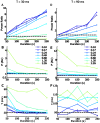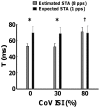Limitations of the spike-triggered averaging for estimating motor unit twitch force: a theoretical analysis
- PMID: 24667744
- PMCID: PMC3965416
- DOI: 10.1371/journal.pone.0092390
Limitations of the spike-triggered averaging for estimating motor unit twitch force: a theoretical analysis
Erratum in
- PLoS One. 2014;9(6):e101614. Yavuz, Utku Ş [corrected to Yavuz, Ş Utku]
Abstract
Contractile properties of human motor units provide information on the force capacity and fatigability of muscles. The spike-triggered averaging technique (STA) is a conventional method used to estimate the twitch waveform of single motor units in vivo by averaging the joint force signal. Several limitations of this technique have been previously discussed in an empirical way, using simulated and experimental data. In this study, we provide a theoretical analysis of this technique in the frequency domain and describe its intrinsic limitations. By analyzing the analytical expression of STA, first we show that a certain degree of correlation between the motor unit activities prevents an accurate estimation of the twitch force, even from relatively long recordings. Second, we show that the quality of the twitch estimates by STA is highly related to the relative variability of the inter-spike intervals of motor unit action potentials. Interestingly, if this variability is extremely high, correct estimates could be obtained even for high discharge rates. However, for physiological inter-spike interval variability and discharge rate, the technique performs with relatively low estimation accuracy and high estimation variance. Finally, we show that the selection of the triggers that are most distant from the previous and next, which is often suggested, is not an effective way for improving STA estimates and in some cases can even be detrimental. These results show the intrinsic limitations of the STA technique and provide a theoretical framework for the design of new methods for the measurement of motor unit force twitch.
Conflict of interest statement
Figures









Similar articles
-
Motor-unit synchronization alters spike-triggered average force in simulated contractions.J Neurophysiol. 2002 Jul;88(1):265-76. doi: 10.1152/jn.2002.88.1.265. J Neurophysiol. 2002. PMID: 12091552
-
Spike-triggered averaging provides inaccurate estimates of motor unit twitch properties under optimal conditions.J Electromyogr Kinesiol. 2018 Dec;43:104-110. doi: 10.1016/j.jelekin.2018.09.008. Epub 2018 Sep 22. J Electromyogr Kinesiol. 2018. PMID: 30267966
-
Robust estimation of average twitch contraction forces of populations of motor units in humans.J Electromyogr Kinesiol. 2017 Dec;37:132-140. doi: 10.1016/j.jelekin.2017.10.005. Epub 2017 Oct 18. J Electromyogr Kinesiol. 2017. PMID: 29101911
-
Human motor units studied by spike-triggered averaging and intraneural motor axon stimulation.Adv Exp Med Biol. 1995;384:147-60. doi: 10.1007/978-1-4899-1016-5_12. Adv Exp Med Biol. 1995. PMID: 8585447 Review.
-
Principles of force gradation in skeletal muscles.Neural Plast. 2003;10(1-2):69-76. doi: 10.1155/NP.2003.69. Neural Plast. 2003. PMID: 14640309 Free PMC article. Review.
Cited by
-
Mathematical relationships between spinal motoneuron properties.Elife. 2022 Jul 18;11:e76489. doi: 10.7554/eLife.76489. Elife. 2022. PMID: 35848819 Free PMC article.
-
Mechanomyographic parameter extraction methods: an appraisal for clinical applications.Sensors (Basel). 2014 Dec 3;14(12):22940-70. doi: 10.3390/s141222940. Sensors (Basel). 2014. PMID: 25479326 Free PMC article.
-
The force-generation capacity of the tibialis anterior muscle at different muscle-tendon lengths depends on its motor unit contractile properties.Eur J Appl Physiol. 2022 Feb;122(2):317-330. doi: 10.1007/s00421-021-04829-8. Epub 2021 Oct 22. Eur J Appl Physiol. 2022. PMID: 34677625 Free PMC article.
References
-
- Heckman C, Enoka RM (2004) Physiology of the motor neuron and the motor unit. Handbook of Clinical Neurophysiology 4: 119–147.
-
- Fuglevand aJ, Winter Da, Patla aE (1993) Models of recruitment and rate coding organization in motor-unit pools. Journal of neurophysiology 70: 2470–2488. - PubMed
-
- Heckman C, Enoka RM (2012) Motor unit. Comprehensive Physiology. - PubMed
Publication types
MeSH terms
LinkOut - more resources
Full Text Sources
Other Literature Sources

